2007 CHEVROLET AVALANCHE height
[x] Cancel search: heightPage 7 of 618
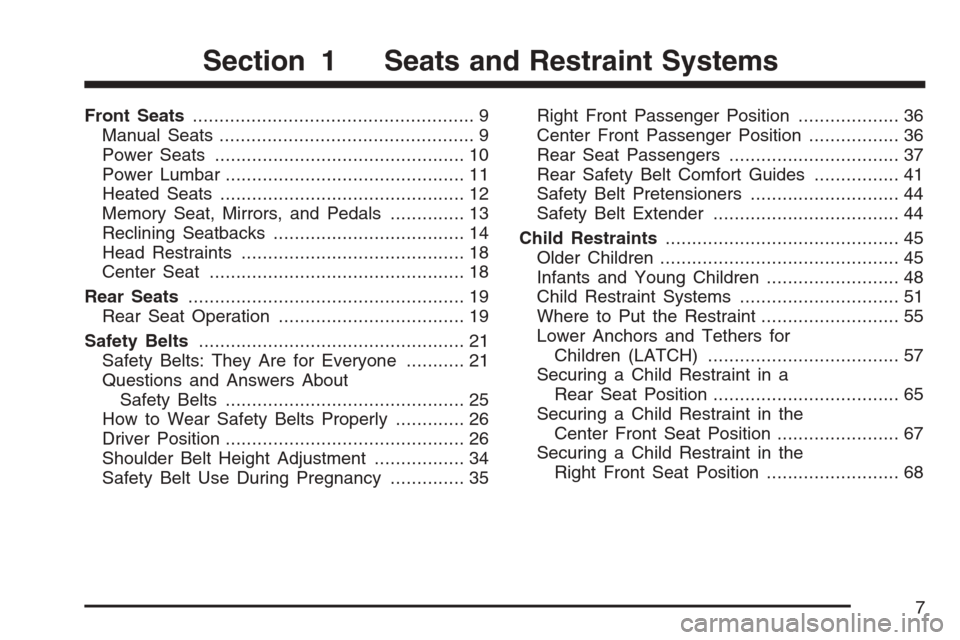
Front Seats..................................................... 9
Manual Seats................................................ 9
Power Seats............................................... 10
Power Lumbar............................................. 11
Heated Seats.............................................. 12
Memory Seat, Mirrors, and Pedals.............. 13
Reclining Seatbacks.................................... 14
Head Restraints.......................................... 18
Center Seat................................................ 18
Rear Seats.................................................... 19
Rear Seat Operation................................... 19
Safety Belts.................................................. 21
Safety Belts: They Are for Everyone........... 21
Questions and Answers About
Safety Belts............................................. 25
How to Wear Safety Belts Properly............. 26
Driver Position............................................. 26
Shoulder Belt Height Adjustment................. 34
Safety Belt Use During Pregnancy.............. 35Right Front Passenger Position................... 36
Center Front Passenger Position................. 36
Rear Seat Passengers................................ 37
Rear Safety Belt Comfort Guides................ 41
Safety Belt Pretensioners............................ 44
Safety Belt Extender................................... 44
Child Restraints............................................ 45
Older Children............................................. 45
Infants and Young Children......................... 48
Child Restraint Systems.............................. 51
Where to Put the Restraint.......................... 55
Lower Anchors and Tethers for
Children (LATCH).................................... 57
Securing a Child Restraint in a
Rear Seat Position................................... 65
Securing a Child Restraint in the
Center Front Seat Position....................... 67
Securing a Child Restraint in the
Right Front Seat Position......................... 68
Section 1 Seats and Restraint Systems
7
Page 11 of 618
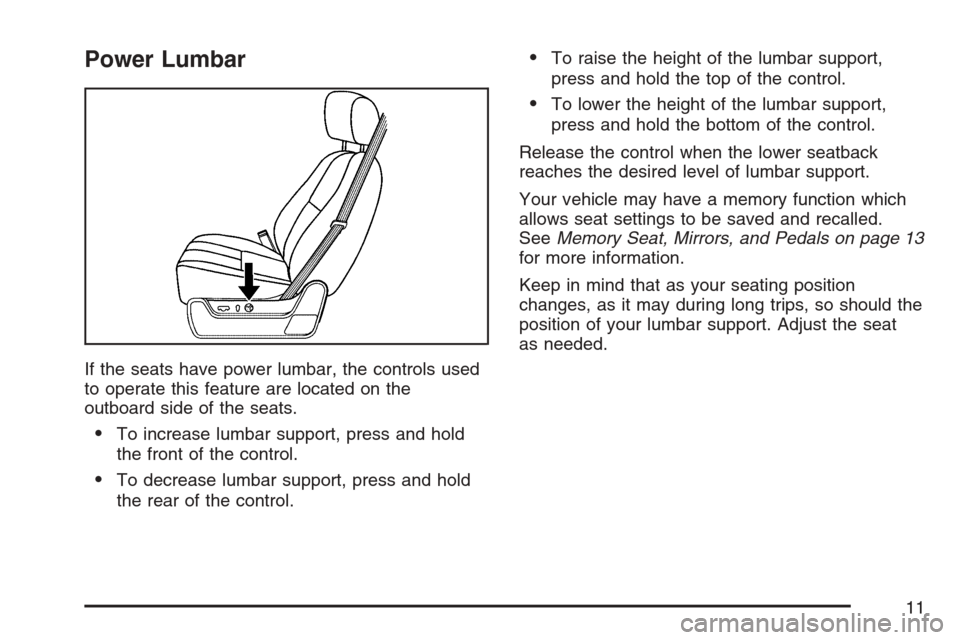
Power Lumbar
If the seats have power lumbar, the controls used
to operate this feature are located on the
outboard side of the seats.
To increase lumbar support, press and hold
the front of the control.
To decrease lumbar support, press and hold
the rear of the control.
To raise the height of the lumbar support,
press and hold the top of the control.
To lower the height of the lumbar support,
press and hold the bottom of the control.
Release the control when the lower seatback
reaches the desired level of lumbar support.
Your vehicle may have a memory function which
allows seat settings to be saved and recalled.
SeeMemory Seat, Mirrors, and Pedals on page 13
for more information.
Keep in mind that as your seating position
changes, as it may during long trips, so should the
position of your lumbar support. Adjust the seat
as needed.
11
Page 18 of 618
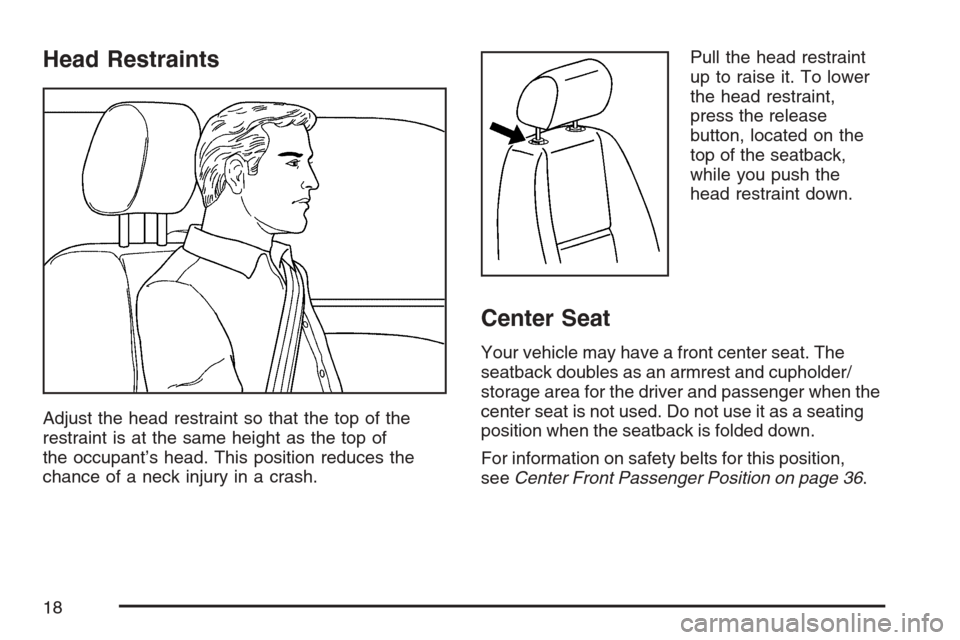
Head Restraints
Adjust the head restraint so that the top of the
restraint is at the same height as the top of
the occupant’s head. This position reduces the
chance of a neck injury in a crash.Pull the head restraint
up to raise it. To lower
the head restraint,
press the release
button, located on the
top of the seatback,
while you push the
head restraint down.
Center Seat
Your vehicle may have a front center seat. The
seatback doubles as an armrest and cupholder/
storage area for the driver and passenger when the
center seat is not used. Do not use it as a seating
position when the seatback is folded down.
For information on safety belts for this position,
seeCenter Front Passenger Position on page 36.
18
Page 27 of 618
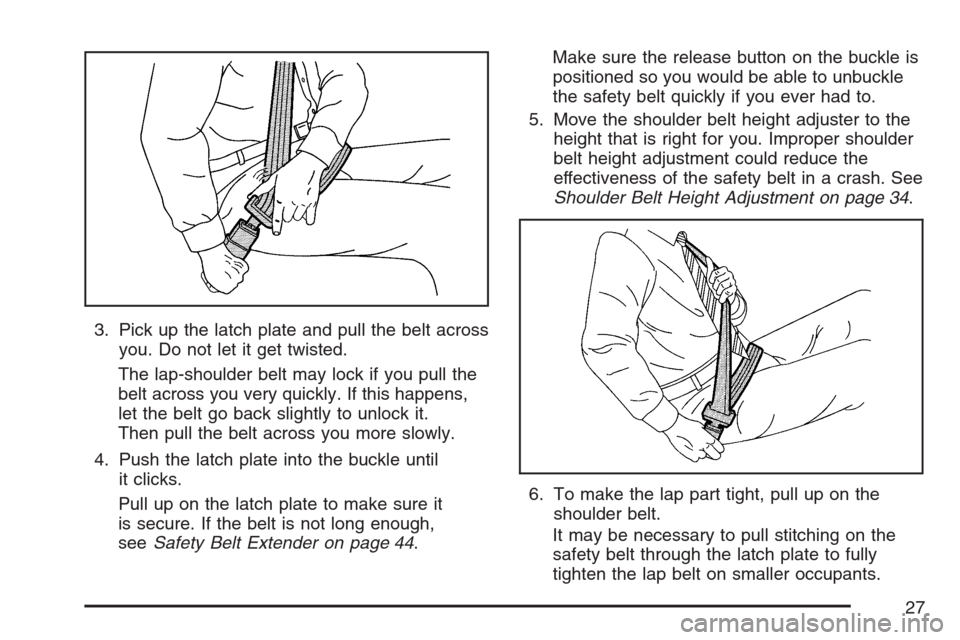
3. Pick up the latch plate and pull the belt across
you. Do not let it get twisted.
The lap-shoulder belt may lock if you pull the
belt across you very quickly. If this happens,
let the belt go back slightly to unlock it.
Then pull the belt across you more slowly.
4. Push the latch plate into the buckle until
it clicks.
Pull up on the latch plate to make sure it
is secure. If the belt is not long enough,
seeSafety Belt Extender on page 44.Make sure the release button on the buckle is
positioned so you would be able to unbuckle
the safety belt quickly if you ever had to.
5. Move the shoulder belt height adjuster to the
height that is right for you. Improper shoulder
belt height adjustment could reduce the
effectiveness of the safety belt in a crash. See
Shoulder Belt Height Adjustment on page 34.
6. To make the lap part tight, pull up on the
shoulder belt.
It may be necessary to pull stitching on the
safety belt through the latch plate to fully
tighten the lap belt on smaller occupants.
27
Page 34 of 618
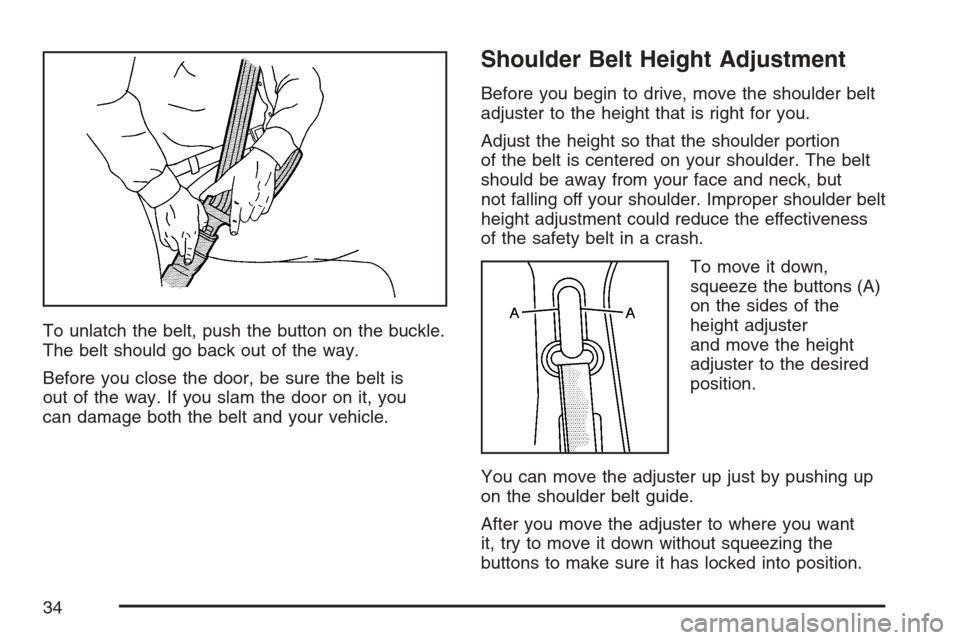
To unlatch the belt, push the button on the buckle.
The belt should go back out of the way.
Before you close the door, be sure the belt is
out of the way. If you slam the door on it, you
can damage both the belt and your vehicle.
Shoulder Belt Height Adjustment
Before you begin to drive, move the shoulder belt
adjuster to the height that is right for you.
Adjust the height so that the shoulder portion
of the belt is centered on your shoulder. The belt
should be away from your face and neck, but
not falling off your shoulder. Improper shoulder belt
height adjustment could reduce the effectiveness
of the safety belt in a crash.
To move it down,
squeeze the buttons (A)
on the sides of the
height adjuster
and move the height
adjuster to the desired
position.
You can move the adjuster up just by pushing up
on the shoulder belt guide.
After you move the adjuster to where you want
it, try to move it down without squeezing the
buttons to make sure it has locked into position.
34
Page 50 of 618
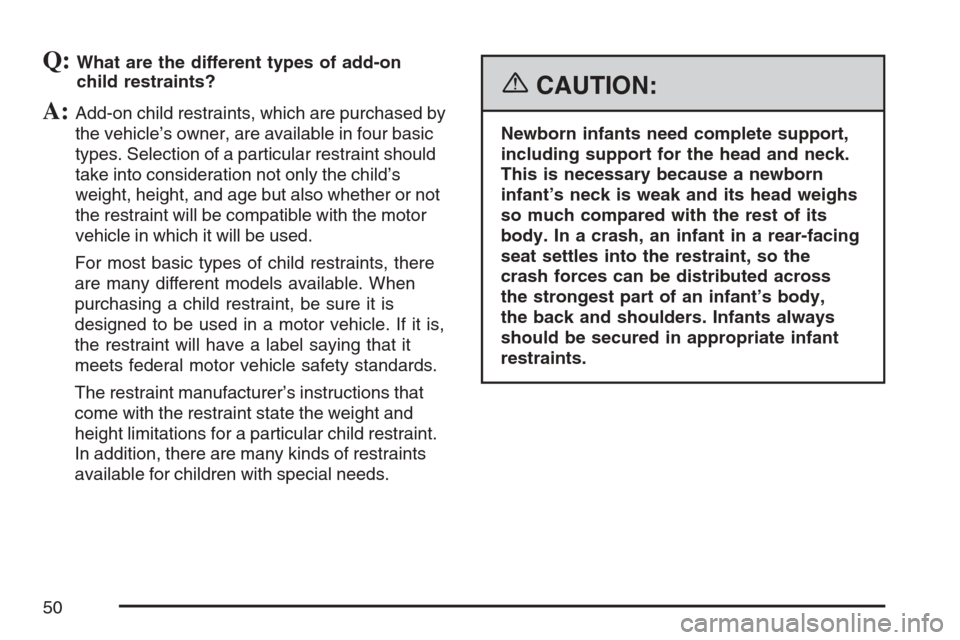
Q:What are the different types of add-on
child restraints?
A:Add-on child restraints, which are purchased by
the vehicle’s owner, are available in four basic
types. Selection of a particular restraint should
take into consideration not only the child’s
weight, height, and age but also whether or not
the restraint will be compatible with the motor
vehicle in which it will be used.
For most basic types of child restraints, there
are many different models available. When
purchasing a child restraint, be sure it is
designed to be used in a motor vehicle. If it is,
the restraint will have a label saying that it
meets federal motor vehicle safety standards.
The restraint manufacturer’s instructions that
come with the restraint state the weight and
height limitations for a particular child restraint.
In addition, there are many kinds of restraints
available for children with special needs.
{CAUTION:
Newborn infants need complete support,
including support for the head and neck.
This is necessary because a newborn
infant’s neck is weak and its head weighs
so much compared with the rest of its
body. In a crash, an infant in a rear-facing
seat settles into the restraint, so the
crash forces can be distributed across
the strongest part of an infant’s body,
the back and shoulders. Infants always
should be secured in appropriate infant
restraints.
50
Page 87 of 618

Adding Equipment to Your
Airbag-Equipped Vehicle
Q:Is there anything I might add to the front
or sides of the vehicle that could keep
the airbags from working properly?
A:Yes. If you add things that change your
vehicle’s frame, bumper system, height, front
end or side sheet metal, they may keep the
airbag system from working properly. Also,
the airbag system may not work properly if you
relocate any of the airbag sensors. If you have
any questions about this, you should contact
Customer Assistance before you modify your
vehicle. The phone numbers and addresses
for Customer Assistance are in Step Two of
the Customer Satisfaction Procedure in this
manual. SeeCustomer Satisfaction Procedure
on page 582.
Q:Because I have a disability, I have to get
my vehicle modi�ed. How can I �nd out
whether this will affect my airbag system?
A:Changing or moving any parts of the
front seats, safety belts, the airbag sensing
and diagnostic module, rollover sensor
module, steering wheel, instrument panel,
overhead console, ceiling headliner, ceiling
and pillar garnish trim, roof-mounted rollover
airbag modules, or airbag wiring can affect the
operation of the airbag system. If you have
questions, call Customer Assistance. The
phone numbers and addresses for Customer
Assistance are in Step Two of the Customer
Satisfaction Procedure in this manual.
SeeCustomer Satisfaction Procedure
on page 582.
87
Page 413 of 618
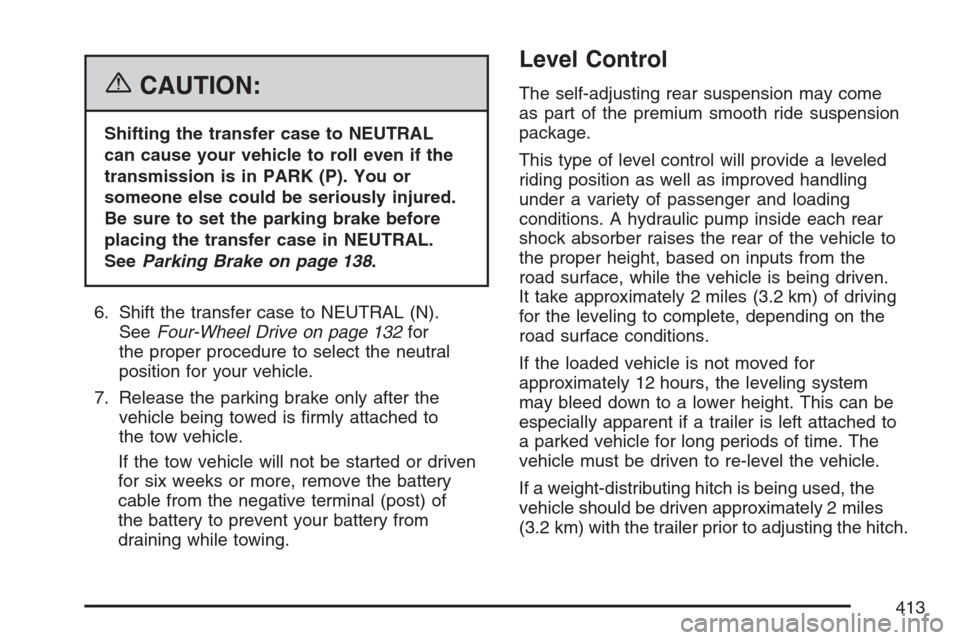
{CAUTION:
Shifting the transfer case to NEUTRAL
can cause your vehicle to roll even if the
transmission is in PARK (P). You or
someone else could be seriously injured.
Be sure to set the parking brake before
placing the transfer case in NEUTRAL.
SeeParking Brake on page 138.
6. Shift the transfer case to NEUTRAL (N).
SeeFour-Wheel Drive on page 132for
the proper procedure to select the neutral
position for your vehicle.
7. Release the parking brake only after the
vehicle being towed is �rmly attached to
the tow vehicle.
If the tow vehicle will not be started or driven
for six weeks or more, remove the battery
cable from the negative terminal (post) of
the battery to prevent your battery from
draining while towing.
Level Control
The self-adjusting rear suspension may come
as part of the premium smooth ride suspension
package.
This type of level control will provide a leveled
riding position as well as improved handling
under a variety of passenger and loading
conditions. A hydraulic pump inside each rear
shock absorber raises the rear of the vehicle to
the proper height, based on inputs from the
road surface, while the vehicle is being driven.
It take approximately 2 miles (3.2 km) of driving
for the leveling to complete, depending on the
road surface conditions.
If the loaded vehicle is not moved for
approximately 12 hours, the leveling system
may bleed down to a lower height. This can be
especially apparent if a trailer is left attached to
a parked vehicle for long periods of time. The
vehicle must be driven to re-level the vehicle.
If a weight-distributing hitch is being used, the
vehicle should be driven approximately 2 miles
(3.2 km) with the trailer prior to adjusting the hitch.
413